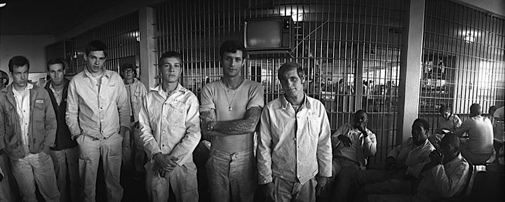This page of photographs (and links) are included to guide members to interesting, evocative, noteworthy visual images/collections. If you have any images or collections of your own, or others to share (provided they are appropriately credited) please forward the image or link for inclusion.

Click on the photograph above for a link to a photo gallery of the London Cans Festival 2008, while a bit dated, is an excellent showcase for the range of ephemeral street art from a collection of artists. While less glitzy and more gritty than its antithesis, the Cannes Film Festival, “Cans” nonetheless was a crowd favourite. This gallery also encourages viewers to consider how the commodification of dissent in the the work of Banksy, Solo One, and others speaks to wider narratives about the commodification of deviance increasingly acknowledge in Criminology, and particular Cultural Criminology.

The photograph above comes from the Wooster Collective’s Billboard Liberation blog. The Wooster Collective, based in NYC serves as something of an ad hoc repository of billboard liberations, culture jams, and other politically informed/inspired street art.

The collection of photographs taken by Angel Franco nearly 30 years ago capture a city in the grips of a crime wave. The images capture the undeniable brutality of a city ‘under siege’. Citizens brutalizing one another and the Police occasionally brutalizing the citizens. The images also capture the unmistakable humanity that was equally prevalent. Most troubling, however, the photographs convey a certain honesty that is almost certainly lost in an age where photographers are kept at arms length for fear that the reality they capture may contradict the reality presented in carefully screened Police press releases and carefully choreographed “reality” television programmes.
The article links to the Harvard University School of Law’s Crime Broadsides Project. Broadsides were publications sold to the gathered crowds at public executions. Much like game programmes at a sporting event the broadsides recounted the crime, often in a highly sensationalized manner, and the subsequent trial. It is not hard to imagine how broadsides such as this might have served to work up the crowd watching Damian’s gruesome execution famously described in Foucault’s Discipline and Punishment.

Photographer Martha Cooper looks back at the rise of the “Furtive Arts”, (graffiti, street art, vandalism, writing or tagging to the rest of us) in New York City, which she chronicled from its infancy.
The photograph above comes from Bruce Jackson’s collection entitled ‘Cummins Widelux 1975’. These images along with several other collections anchored his book Killing Time (1978) exploring the lives and stories of the prisoners and guards who called the notoriously inhumane Cummins Prison Farm in tiny Grady, Arkansas, USA. Despite long standing allegations of human rights abuses Jackson was allowed largely unfettered access to the grounds, barracks, and people.
Bruce Jackson’s prison photographs were also published recently in a NY Times interactive gallery entitled ‘A Wide View of a Hellish World’. This short article gives great insight into the project of this ‘accidental photographer’.
WPI Photo of the Year Gallery – Photo © Luiz Vasconcelos/Reuters
The photograph above links to the Telegraph.co.uk page dedicated to the WPI Photograph of the Year contest. The other photographs, while not all so powerfully tied to the question of human rights, are no less evocative, if occasionally even hopeful!

The screen shot above links to a small photo collection by Hugo Leglise-Bataille exploring the role and practice of photographing political protests and confrontations. It raises interesting questions about the production of information and evidence in the public (and protest) sphere and what we as criminologists might make of this documentation.


This might be interesting for some of you as well:
http://broadsides.law.harvard.edu/home.php
A collection of historical British broadsides